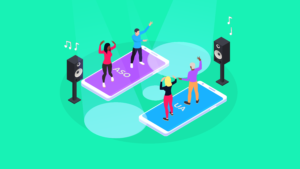Author: Steffen Meyer, Mobile Marketing Content Specialist
There were days when one product page ruled them all and app marketers linked every ad campaign to one and the same target in the App Store, causing inevitable rifts in the user journey.
But these days are no more.
Apple’s introduction of custom product pages in December 2021 may not sound that epic to people outside of the app marketing bubble, but for those inside of it, it does have the feel of a new era.
Close gaps between ad and app
Instead of only having one and the same product page for your app, you can now create up to 35 different pages, each one with custom screenshots, app previews, promotional texts, and links.
This allows you to create tailor-made product pages for your individual campaigns and so close gaps between ad campaigns and App Store.
These smooth transitions are not only a nice-to-have but translate into hard KPIs because according to research by Storemaven, better conversion rates depend on
- How close the messaging on the ad creative level is to the messaging on the App Store product page
- The preferences of a specific segment of your audience and the messaging on the App Store
With custom pages, you can exactly fulfill these prerequisites and boost conversion rates. Here are a few ideas to do so:
1. Features
When your app has several functions, features or benefits you want to highlight each of those in custom pages.
Example: For an organizing app you can create custom pages for the time recording and the task management feature each. When launching a keyword search campaign you link these pages accordingly. So when someone looks for a „time recording app“ and clicks on your store link, he will see this particular function on your product page, and when someone looks for „task management“, the other product page will show up
2. Content
If your app offers different content, you should create custom pages accordingly.
Example: A movie streaming app focuses on old western movies, detective stories, and romantic comedies. For each of these categories, you should create a custom product page with specific movies and link these pages accordingly for example in Facebook ad campaigns. This way, you not only target exactly those with a desire for a specific genre but show them their favorite movies in the App Store, too.
3. Location
When the results or the functionality of an app depends on the location of the user, your custom pages should reflect this.
Example: An app presents its users intimate concerts of rather unknown bands in various cities. You can customize the product pages with screenshots of event locations situated in the home city of your target audience. When seeding your app to local influencers, you provide links to these locally adjusted product pages, so you appeal to the local patriotism of your soon-to-be users that recognize their favorite venues.
4. Sources
Depending on where your campaigns run, you should adjust your product pages accordingly.
Example: You paid a Youtube influencer to promote your fantasy gaming app and they did so in their very own style by using a so-called „Lord-of-the-rings-o-meter“. To keep interested people hooked, you could implement this „Lord-of-the-rings-o-meter“ on your custom product page as well. Of course, ask for their permission beforehand.
5. Demographics
When you run ad campaigns for different ages and gender, you want to customize your product pages as well.
Example: For an app that provides various workout videos, you should create custom pages highlighting exercises that fit certain age groups. This way, the 80+ folks probably won’t see the 30-minute high intensity training practiced by a trainer in their 20s but rather the mobility exercise by someone in their age group – which probably makes them feel more comfortable, resulting in better conversion rates.
6. A/B Testing
Use custom product pages to compare the performance of different screenshots, app previews, or promotional texts with each other.
Example: For the workout video app from the last example, you have set up the campaign for the 80+ folks but you would like to know if the female or the male trainer will result in more conversions. To do so, you set up custom pages and corresponding ad campaigns for each of them. Then you watch the insights and evaluate.
7. Promotions
Set up custom pages for special offers that only apply to certain users.
Example: Let’s stay with the workout video app and assume you want to get more users in their 80s, which is why you offer them a membership at a lower price. Since this special offer does not apply to anyone younger than 80, you don’t want those people to get confused. So you create a custom page with the special offer and link it in the 80+ campaign but not in the campaigns targeting younger audiences.
This is just the beginning
There are many more ways to make use of custom product pages (just have a look at this playbook by storemaven) and we at Customlytics are here to give advice and implement them. Just contact us. Furthermore, you want to get our Marketing Master Map, since it will help you to spot and close more gaps in your ASO and overall app marketing strategy.
💡 Knowledge sharing is at the core of what we do. Learn more about the app industry and discover useful resources by signing up for our newsletter or becoming part of our community on LinkedIn, Twitter, Glassdoor or Instagram.
Helpful Links:







